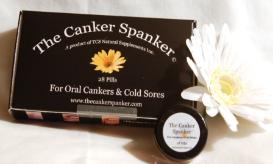Review: The Canker Spanker – Oral Canker & Cold Sore Relief

I’m one who will ALWAYS go for a natural cure before seeking pharmaceuticals. I’m also one that is prone to Canker Sores and my poor son gets Cold Sores all the time! So when I was asked to review a natural supplement to get rid of these issues, I was all excited. I actually have a canker sore on my top lip right now…I can’t stop licking it either, I hate that! If you are reading this, you might be experiencing this problem too, also check this dermal repair complex reviews and learn something useful that can benefit you.
Anyway, when it arrived, I started reading the ingredients. Some I recognized, some I didn’t, but most didn’t seem to be any good for the issue at hand, so I decided to look them up.
——————————————————–
Ingredients:
Calcium Carbonate – Eggshells, Snail Shells and most Seashells are predominantly calcium carbonate and can be used as industrial sources of that chemical.
Cellulose – Cellulose is the structural component of the primary cell wall of green plants, many forms of algae and the oomycetes. Some species of bacteria secrete it to form biofilms. Cellulose is the most common organic compound on Earth.
Ferrous Sulfate – Ferrous sulfate is a type of iron. You normally get iron from the foods you eat.
Pregelatinized Corn Starch – Pregelatinized starch is a processed carbohydrate, used as a texturizer and/or binder. It is typically derived from corn, waxy corn, potato, or tapioca. It has nothing to do with gelatin. It is safe for vegetarians and vegans.
Croscarmellose sodium – Its purpose in most tablets – including dietary supplements – is to assist the tablet in disintegrating in the intestinal tract at the required location.
Silicon Dioxide – Also known as silica. Silica is a common additive in the production of foods, where it is used primarily as a flow agent in powdered foods, or to absorb water inhygroscopic applications.
Red 40 Lake – An insoluble food coloring found in foods, candies, drinks and more.
The Center for Science in the Public Interest (CSPI) has petitioned the Food and Drug Administration (FDA) to ban artificial food dyes. Studies have shown that dyes cause hyperactivity in some children.
Food dyes have been suspected of causing behavior problems since the 1970s when Dr. Ben Feingold, a San Francisco allergist, took his patients off food colorings, the basis for the Feingold Diet. Their behavior improved, he reported.
Talc – Talc is also used as food additive or in pharmaceutical products as a glidant. In medicine talc is used as a pleurodesis agent to prevent recurrent an abnormal collection of air or gas that may interfere with normal breathing.
Magnesium Sterarate – They spelled it incorrectly on their label, it is supposed to be spelled “magnesium stearate” Magnesium stearate is often used as a diluent[3] in the manufacture of medical tablets, capsules and powders.
Sodium Lauryl Sulfate – Sodium laureth sulfate, or sodium lauryl ether sulfate (SLES), is a detergent andsurfactant found in many personal care products (soaps, shampoos, toothpaste etc.).
Titanium Dioxide – Titanium dioxide accounts for 70% of the total production volume of pigments worldwide. It is widely used to provide whiteness and opacity to products such as paints, plastics, papers, inks, foods, and toothpastes. It is also used in cosmetic and skin care products, and it is present in almost every sunblock, where it helps protect the skin from ultraviolet light.
Blue 2 Lake – As a blue color, Brilliant Blue FCF is often found in ice cream, canned processed peas, packet soups, bottled food colorings, icings, ice pops, blue raspberry flavored products,dairy products, sweets and drinks,especially the liqueur blue curacao. It is also used insoaps, shampoos, mouthwash and other hygiene and cosmetics applications.
Oil of Alternifolia – Characteristic of the myrtle family Myrtaceae, it is used to distil essential oil. It is the primary species for commercial production of Tea tree oil (melaleuca oil), a topical antibacterial andantifungal used in a range of herbal medicine products including antiseptics, deodorants,shampoos, soaps and lotions.
——————————————————–
So, most of the ingredients are used to create the pill itself. One of the ingredients, sodium lauryl sulfate, actually CAUSES canker sores and can be found in toothpaste. If your toothpaste has this in it, and you switch, you may find that you have less sores.
The only active ingredient is Oil of Alternifolia, which is just Tea Tree Oil! I don’t think that I have to call Mythbusters on this one. I am busting this pill all on my own. I say you swish with some salt water (YES it WILL hurt! But it will clean it too!) or put a dab of Tea Tree Oil on it every couple of hours.
I don’t think this “magic pill” is your answer, and may actually increase your pain or amount of sores you get.
I love natural remedies, but just because it is natural, doesn’t mean it is good for you. Remember, arsenic is natural as well.



